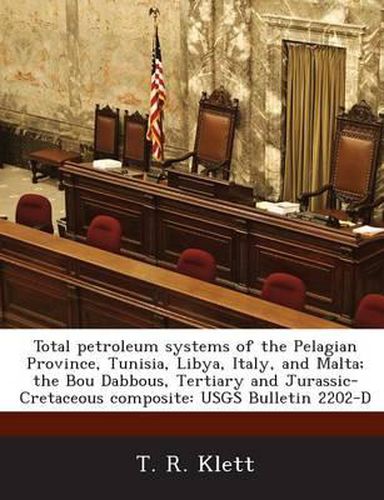Readings Newsletter
Become a Readings Member to make your shopping experience even easier.
Sign in or sign up for free!
You’re not far away from qualifying for FREE standard shipping within Australia
You’ve qualified for FREE standard shipping within Australia
The cart is loading…






Undiscovered conventional oil and gas resources were assessed within total petroleum systems of the Pelagian Province (2048) as part of the U.S. Geological Survey World Petroleum Assessment 2000. The Pelagian Province is located mainly in eastern Tunisia and northwestern Libya. Small portions of the province extend into Malta and offshore Italy. Although several petroleum systems may exist, only two ?composite? total petroleum systems were identified. Each total petroleum system comprises a single assessment unit. These total petroleum systems are called the Bou Dabbous?Tertiary and Jurassic-Cretaceous Composite, named after the source-rock intervals and reservoir-rock ages. The main source rocks include mudstone of the Eocene Bou Dabbous Formation; Cretaceous Bahloul, Lower Fahdene, and M?Cherga Formations; and Jurassic Nara Formation. Known reservoirs are in carbonate rocks and sandstone intervals throughout the Upper Jurassic, Cretaceous, and Tertiary sections. Traps for known accumulations include fault blocks, low-amplitude anticlines, high-amplitude anticlines associated with reverse faults, wrench fault structures, and stratigraphic traps. The estimated means of the undiscovered conventional petroleum volumes in total petroleum systems of the Pelagian Province are as follows: [MMBO, million barrels of oil; BCFG, billion cubic feet of gas; MMBNGL, million barrels of natural gas liquids] Total Petroleum System MMBO BCFG MMBNGL Bou Dabbous?Tertiary 667 2,746 64 Jurassic-Cretaceous Composite 403 2,280 27
$9.00 standard shipping within Australia
FREE standard shipping within Australia for orders over $100.00
Express & International shipping calculated at checkout
Undiscovered conventional oil and gas resources were assessed within total petroleum systems of the Pelagian Province (2048) as part of the U.S. Geological Survey World Petroleum Assessment 2000. The Pelagian Province is located mainly in eastern Tunisia and northwestern Libya. Small portions of the province extend into Malta and offshore Italy. Although several petroleum systems may exist, only two ?composite? total petroleum systems were identified. Each total petroleum system comprises a single assessment unit. These total petroleum systems are called the Bou Dabbous?Tertiary and Jurassic-Cretaceous Composite, named after the source-rock intervals and reservoir-rock ages. The main source rocks include mudstone of the Eocene Bou Dabbous Formation; Cretaceous Bahloul, Lower Fahdene, and M?Cherga Formations; and Jurassic Nara Formation. Known reservoirs are in carbonate rocks and sandstone intervals throughout the Upper Jurassic, Cretaceous, and Tertiary sections. Traps for known accumulations include fault blocks, low-amplitude anticlines, high-amplitude anticlines associated with reverse faults, wrench fault structures, and stratigraphic traps. The estimated means of the undiscovered conventional petroleum volumes in total petroleum systems of the Pelagian Province are as follows: [MMBO, million barrels of oil; BCFG, billion cubic feet of gas; MMBNGL, million barrels of natural gas liquids] Total Petroleum System MMBO BCFG MMBNGL Bou Dabbous?Tertiary 667 2,746 64 Jurassic-Cretaceous Composite 403 2,280 27